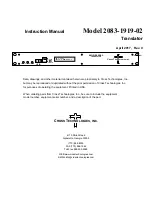
Song Mode
Edit Song: ARRANGE Page
12-47
Step
The number of steps in an arrangement defaults to 1. All other steps are then added when
needed. The step of the Arrangement selected for editing is displayed as the Step. Use the
CHAN/BANK arrows to select the different steps in your Arrangement. StartStep on the
EditSong: COMMON page, as well as the key ranges of the steps, control what steps are
played.
The behavior and control of each step is deÞned with the parameters described below.
Song
The Song is the ID# and name of a Song Object in memory that will play back in proper
numerical order with the other steps in an arrangement or will respond to any triggering from
a deÞned keyboard range in that step. This songÕs (up to) 16 tracks will play in addition to any
tracks in the current song.
Mutes
The possible sixteen tracks of the current stepÕs Song can be individually muted. When the
selected stepÕs display has tracks with an (M) in this Þeld, those tracks will be muted during
play back of the Song in the Arrangement.
Xpose
Each Step in an Arrangement can impose a transposition on the Song selected in its Song
parameter during playback. Xpose determines how many semitones a StepÕs Song is
transposed above or below the SongÕs original key during playback of that step in an
Arrangement.
All tracks of a Song being transposed as a Step will be transposed, except for those tracks
deÞned as a Drum Track in the EditSong : COMMON page of the Song called up by the
Arrangement, NOT the Arrangement Song itself.
Times
The number of times that a Song is looped before an Arrangement moves on to its next Step can
be determined with Times. You can set this value to repeat the Song up to 120 times before the
next Step is played. An inÞnite loop can be set for any Step, but the Arrangement will play that
Step until
Stop
is pressed.
Mode
The Mode setting found in the Arrangement editor determines whether an Arrangement plays
the next Step or if the sequencer will stop after playing the current Step.
Triggering Steps from a Key
There are four parameters along the bottom of the Arrangement edit page that are settings for
real time control of the Steps in an Arrangement. Triggering and transposing Steps from a MIDI
keyboard, transmitting on the TriggerChan (see page 12-26), is possible when the TriggerCtl
parameter, found on the COMMON page, is set to ON, or when the selected controller input
activates arrangement control.
LowKey
The Þrst parameter, LowKey, is the setting for the lowest note in a keyboard range, that when
played by the TriggerChan, will trigger the start of the current Step. Triggering a Step from the
LowKey will play back its Song in its original key transposed the number of semitones set in
the Xpose setting. As you play up the keyboard chromatically, the Step will transpose its Song
Summary of Contents for K2500RS
Page 12: ...Table of Contents TOC 12...
Page 16: ...Introduction How to use this manual 1 4...
Page 32: ...User Interface Basics The Panel Play Feature K2vxR 3 8...
Page 106: ...Effects Mode and the Effects Editor Configurations and Parameters 9 24...
Page 186: ...Song Mode Recording Multi timbral Sequences via MIDI 12 52...
Page 304: ...DSP Functions Hard Sync Functions 14 52...
Page 394: ...Programs Setups and Keymaps K2500 ROM Keymaps 21 12...
Page 402: ...LFOs LFO Shapes 23 4...
Page 406: ...Note Numbers and Intonation Tables List and Description of Intonation Tables 24 4...
Page 434: ...DSP Algorithms 26 14...
Page 450: ...MIDI and SCSI Sample Dumps SMDI Sample Transfers 29 8...
Page 464: ...Glossary 31 6...
Page 490: ...K2vx Program Farm VOX K25 Appendix A 22...
Page 494: ...K2vx Compatibility Converting programs from the K2vx to K2000 Appendix B 4...
















































